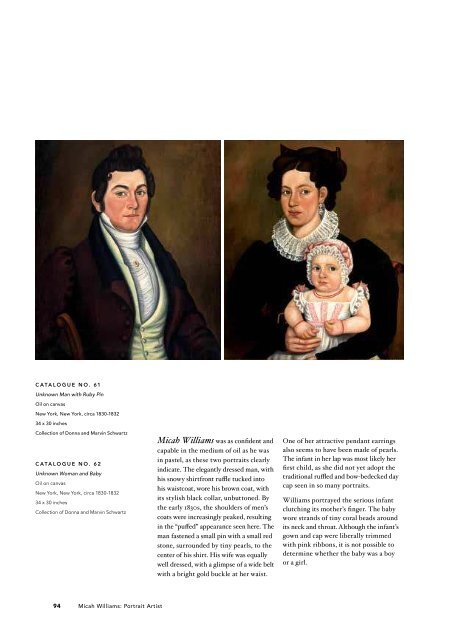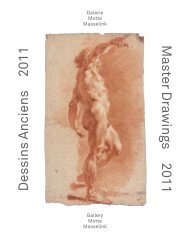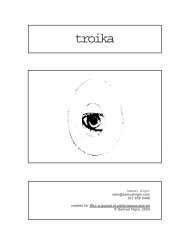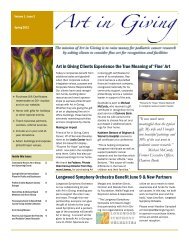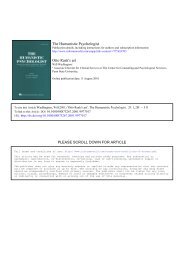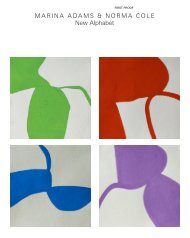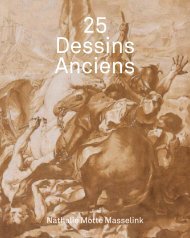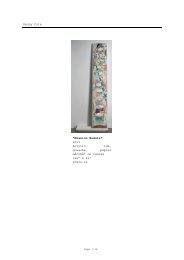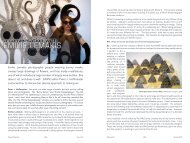Micah Williams Portrait Artist - Icompendium
Micah Williams Portrait Artist - Icompendium
Micah Williams Portrait Artist - Icompendium
Create successful ePaper yourself
Turn your PDF publications into a flip-book with our unique Google optimized e-Paper software.
cAtAlogue no. 61<br />
Unknown Man with Ruby Pin<br />
Oil on canvas<br />
New York, New York, circa 1830-1832<br />
34 x 30 inches<br />
Collection of Donna and Marvin Schwartz<br />
cAtAlogue no. 62<br />
Unknown Woman and Baby<br />
Oil on canvas<br />
New York, New York, circa 1830-1832<br />
34 x 30 inches<br />
Collection of Donna and Marvin Schwartz<br />
<strong>Micah</strong> <strong>Williams</strong> was as confident and<br />
capable in the medium of oil as he was<br />
in pastel, as these two portraits clearly<br />
indicate. The elegantly dressed man, with<br />
his snowy shirtfront ruffle tucked into<br />
his waistcoat, wore his brown coat, with<br />
its stylish black collar, unbuttoned. By<br />
the early 1830s, the shoulders of men’s<br />
coats were increasingly peaked, resulting<br />
in the “puffed” appearance seen here. The<br />
man fastened a small pin with a small red<br />
stone, surrounded by tiny pearls, to the<br />
center of his shirt. His wife was equally<br />
well dressed, with a glimpse of a wide belt<br />
with a bright gold buckle at her waist.<br />
One of her attractive pendant earrings<br />
also seems to have been made of pearls.<br />
The infant in her lap was most likely her<br />
first child, as she did not yet adopt the<br />
traditional ruffled and bow-bedecked day<br />
cap seen in so many portraits.<br />
<strong>Williams</strong> portrayed the serious infant<br />
clutching its mother’s finger. The baby<br />
wore strands of tiny coral beads around<br />
its neck and throat. Although the infant’s<br />
gown and cap were liberally trimmed<br />
with pink ribbons, it is not possible to<br />
determine whether the baby was a boy<br />
or a girl.<br />
cAtAlogue no. 63<br />
Unknown Mother and Child<br />
with Raspberries<br />
Oil on canvas<br />
New York, New York, circa 1830-1832<br />
43 1 ⁄2 x 33 ³⁄4 inches<br />
Collection of Edward King, Jr.<br />
1. Jo B. Paoletti. Pink and Blue: Telling the Girls<br />
from the Boys in America (Bloomington, IN:<br />
Indiana University Press, 2012) 27.<br />
2. Martha Gandy Fales. Jewelry in America<br />
1600-1900 (Suffolk, England: Antique<br />
Collectors’ Club, 1995) 57.<br />
This portrait is one of <strong>Micah</strong><br />
<strong>Williams</strong>’ most evocative oil works. The<br />
unknown woman posed with her baby<br />
in her lap, her right arm supporting the<br />
infant, while in her left hand she cupped<br />
raspberries from which the child selected<br />
a juicy berry. There are several clues<br />
within the portrait to indicate that the<br />
woman may have been one of New York’s<br />
numerous foreign born residents.<br />
The unknown lady wore her hair<br />
much differently from the majority of<br />
<strong>Williams</strong>’ female sitters. She coiled her<br />
hair asymmetrically, holding it in place<br />
with a beautifully carved white comb,<br />
possibly made of ivory. The woman’s<br />
dress differed from the accepted<br />
daywear typical for American women.<br />
The black gown, possibly of silk, was<br />
made with a series of broad horizontal<br />
pleats or tucks on either side of the<br />
bodice. The woman did not wear the<br />
usual white ruffled fichu, shawl, or collar.<br />
Instead, a band of black lace edged the<br />
wide boat neck of her dress.<br />
The unknown woman’s jewelry was<br />
rendered with the precision <strong>Williams</strong><br />
used in depicting the personal accessories<br />
of all his sitters. She wore heavy<br />
gold pendant earrings set with what<br />
appear to be garnets. She tucked into<br />
the waistband of her dress a gold pocket<br />
watch, attached to a thick gold chain<br />
with a pearl and gold filigree watch fob.<br />
The sturdy and well-dressed baby appears<br />
to be about twelve months old. A large<br />
rosette of blue satin ribbon ornamented<br />
the baby’s elaborately ruffled cap but<br />
gives no clue to the infant’s gender.<br />
The modern gender color usage of pink<br />
for girls and blue for boys was not<br />
popularized in the United States until<br />
the 1940s. (1) The front panel of the<br />
baby’s dress was richly embroidered, its<br />
full skirts contrasting starkly against the<br />
mother’s black dress. The baby also wore<br />
a good deal of coral jewelry. Coral was<br />
thought to have protective qualities for<br />
the wearer and as such was a favorite for<br />
children’s and infants’ jewelry. (2) The<br />
eye-catching gilt emblem in the lower<br />
left corner appears to be the decorative<br />
upholstery ornamentation of the sofa<br />
arm upon which the child was seated.<br />
94 <strong>Micah</strong> <strong>Williams</strong>: <strong>Portrait</strong> <strong>Artist</strong> <strong>Micah</strong> <strong>Williams</strong>: <strong>Portrait</strong> <strong>Artist</strong> 95


